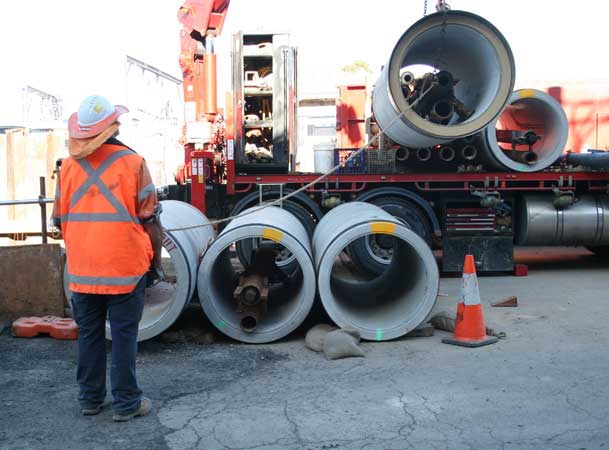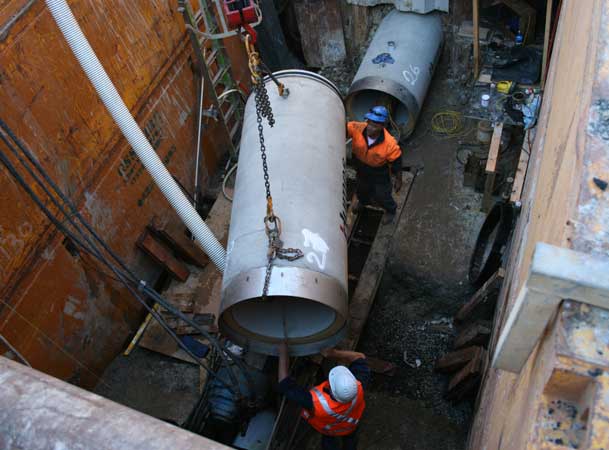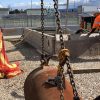Microtunneling beneath railway is a very difficult project – dealing with ground changes from clay to rock, and you can imagine the major problems that could be caused by a microtunnelling head failure, or if the microtunnelling head was to encounter an obstruction – work has to stop and you could potentially have a microtunnelling head stuck under an operating railway.”
The below examples are all projects that the team from Pezzimenti Tunnelbore successfully completed. All of these microtunnels were over weekends – working 24 hours a day to minimise the disruption for rail passengers – and were delivered on time, while navigating the difficult conditions. .
Sydneham – Microtunnelling under the railway station
Sydney Water required a 560 mm watermain to be constructed under the railway station at Sydenham, Sydney. The main contract was won by Diona Constructions, who then let the microtunnelling work to Pezzimenti Tunnelbore. The microtunnelling was scheduled to be carried out during a rail shutdown over the weekend 18-19 May 2013.



Diona Constructions excavated the 4.5 m deep launch shaft so the jacking frame could be lowered well in advance of the shutdown weekend. As the launch shaft was 38 m from the Railcorp property line, this distance was able to be pipe jacked prior to the weekend shutdown. This left 58 m of 1,020 mm microtunnel to be pipe jacked during the shutdown.
Two crews of five men worked consecutive 12 hour shifts commencing 3 am Saturday morning. The first shift jacked eleven pipes (26 m), the second shift commencing at 3 pm on Saturday afternoon jacked ten pipes (24 m). The next shift had three pipes to jack on their shift and they broke through at 8 am, leaving the remainder of the shift to remove the microtunnelling head from the exit shaft, retract the 39 rods and grout the annular space between the jacking pipes and the microtunnel. The jacking frame and the remainder of the equipment were removed from site over the next couple of days. Diona then welded and inserted the steel main and completed pipework including the connections to the existing reticulation system.
Rooty Hill – Great Western Railway Crossing
Holcim Australia is constructing a large manufacturing facility at Rooty Hill adjacent to the company’s pipe manufacturing works. The high voltage power feed to the new facility required an under line crossing under the Great Western Railway line at Rooty Hill. The crossing was 59 m long, 700 mm diameter jacking in 500 mm Humes S-series RC jacking pipes. Railcorp required the works to be carried out during a weekend rail shutdown in conjunction with scheduled railway maintenance.



The rail shutdown was scheduled from midnight 22 February until midnight 24 February 2013. It was planned to microtunnel the first 16 m prior to the shutdown. The remaining 43 m would be microtunelled (with two crews working consecutive 12 hour shifts) and the annular space between the pipes and the microtunnel grouted during the shutdown.
Wade Engineering handed over the shaft and the jacking frame was established in the days prior to the weekend. The first 16 m was microtunelled by the end of the Friday.
Railcorp delayed the start of the shutdown until 5 am Saturday morning. Microtunnelling commenced in torrential rain. The drilling progress was excellent and all 43 m of microtunnelling was completed by the second crew at 4 pm on the Saturday afternoon. The head was disconnected and the rods removed. The annular gap was grouted on the Sunday and amid the continuing heavy rain over the next few days, the conduits were pushed and the grout around the conduits was poured.
Concord West – Microtunnelling beneath main Northern Railway
Power distributors Ausgrid needed to cross the Main Northern Railway in two locations to extend its network of high voltage feeder lines. The two crossings were approximately 1 km apart and Railcorp required both crossings to be carried out during a weekend rail possession. Railcorp had scheduled a number of weekend possessions at approximately 12 week intervals throughout the year and Ausgrid set the date for the rail crossings to be completed over the weekend 2-3 March 2013. Ausgrid let the head contract to Dunmain.


Dunmain completed the construction of both shafts ready for the establishment of the microtunnelling equipment on site and for the jacking frames to be concreted in by Thursday prior to the weekend. Due to the close proximity of the rail, only a few metres were drilled prior to the rail shutdown. The remaining works – 48 m of 900 mm and 30 m of 700 mm pipe jacking – were required to be completed during the shutdown, which was scheduled to start at midnight Friday night and end midnight Sunday night.
The 20 pipes were jacked in over the weekend, with work proceeding on a 24-hour basis. Breakthrough occurred at 10.30 am on the Sunday. The head was removed, rods retracted and the annular space grouted between the pipes and the microtunnel on the Sunday shift during the shutdown as required. The conduits were inserted and then grout encased in the few days following the weekend. Railcorp required the rails to be constantly monitored in case of rail settlement. No settlement occurred either during or after the microtunnelling works.
Gosford – Microtunnelling beneath Main Northern Railway for Power Supply
Pezzimenti Tunnelbore received a phone call at 4.30 pm on a rainy Saturday afternoon from Diona Constructions. The call came just as a Pezzimenti Tunnelbore 700 mm head was breaking through on a rail crossing microtunnel at West Concord for Ausgrid.
“I know what the answer is, but I must ask,” the Diona representative said. “Can you come to Gosford tomorrow and complete a 700 mm x 66 m long microtunnel by midnight tomorrow night?”
Unsurprisingly, he got his expected answer. But by the following week, Pezzimenti Tunnelbore had inspected the Gosford site and began preparations for the works.
Ausgrid required a high voltage power cable to cross under the main Northern Railway just north of Gosford in order to provide an alternate power supply to consumers on the western side of the railway. A major facility requiring the security of an alternative supply was Gosford hospital.
Diona Constructions had originally awarded the contract for the boring to an interstate auger-boring company as Pezzimenti Tunnelbore was unavailable for the project. The interstate contractor arrived on-site prior to the shutdown but then needed to modify equipment before he was able to commence drilling, losing valuable rail shutdown time on the Saturday morning. After 4 m of the total 66 m bore was completed, a mechanical failure of their equipment stopped all drilling on the Saturday morning of the rail shutdown. Hence the phonecall from Diona Constructions, asking Pezzimenti Tunnelbore to urgently make their way to Gosford.
When the team from Pezzimenti Tunnelbore arrived on-site, arrangements were made to modify the shaft – the 10 m shaft was reduced to 6 m long – and develop a program for completion. Ausgrid were hopeful that due to the urgency of the works Railcorp would approve the microtunnelling to be completed under live rail traffic conditions.
Pezzimenti Tunnelbore proposed to work three 12 hour shifts 6 am until 6 pm for three consecutive days – 22-24 March 2013. The proposal was approved by Railcorp and Diona made the necessary changes to the shaft to enable commencement of the microtunnelling by lunchtime on 22 March.
Work continued in the single 12 hour shift on the Saturday and breakthrough occurred mid-morning on 24 March. The slurry spoil was carted some 103 km to a licensed waste facility using four of Pezzimenti Tunnelbore’s vacuum tanker and vacuum bin/hook truck combination units.























